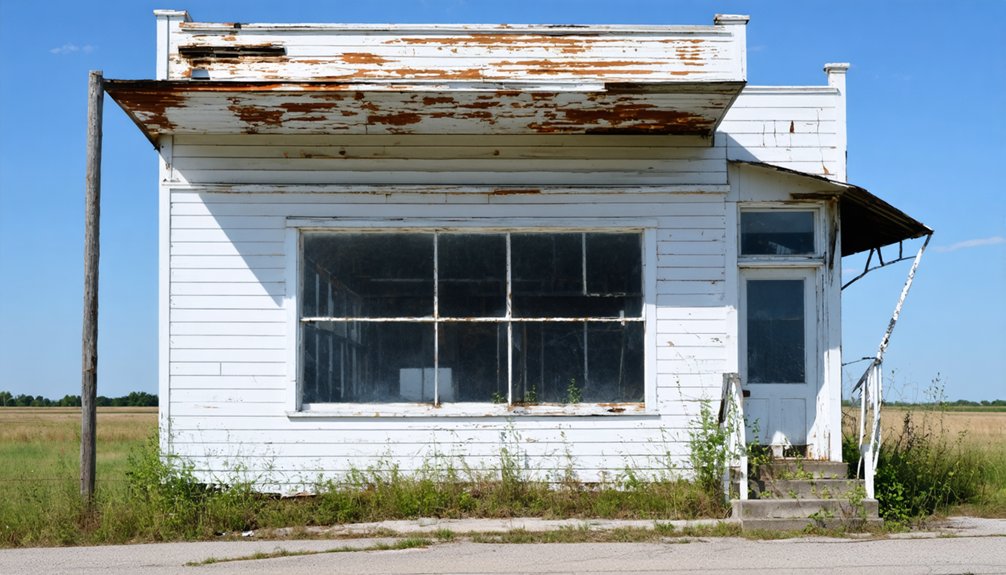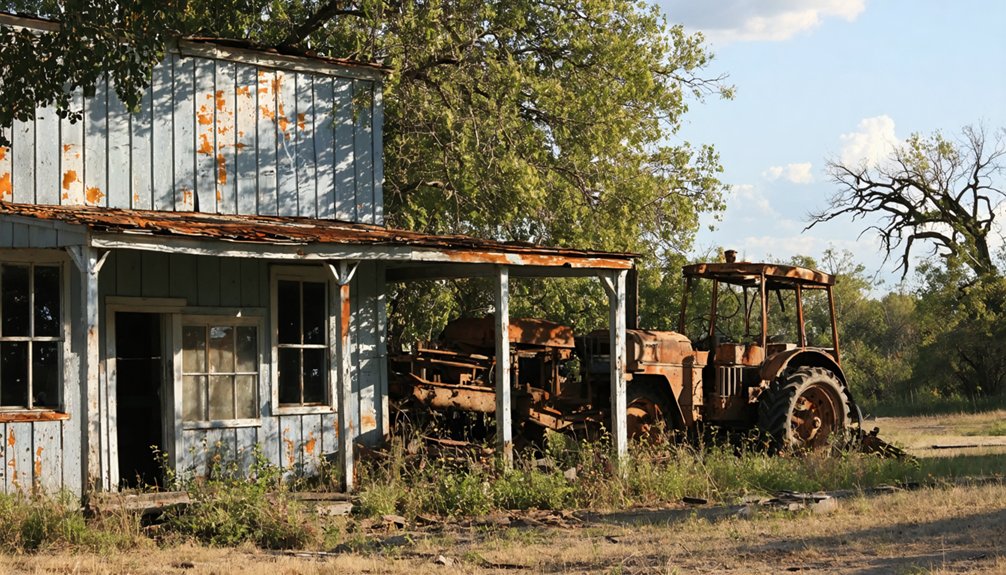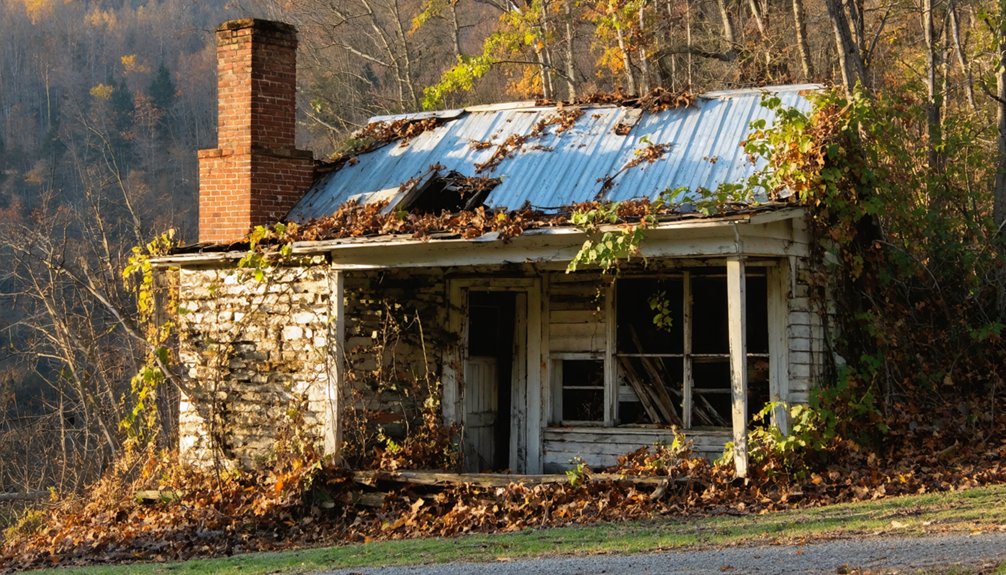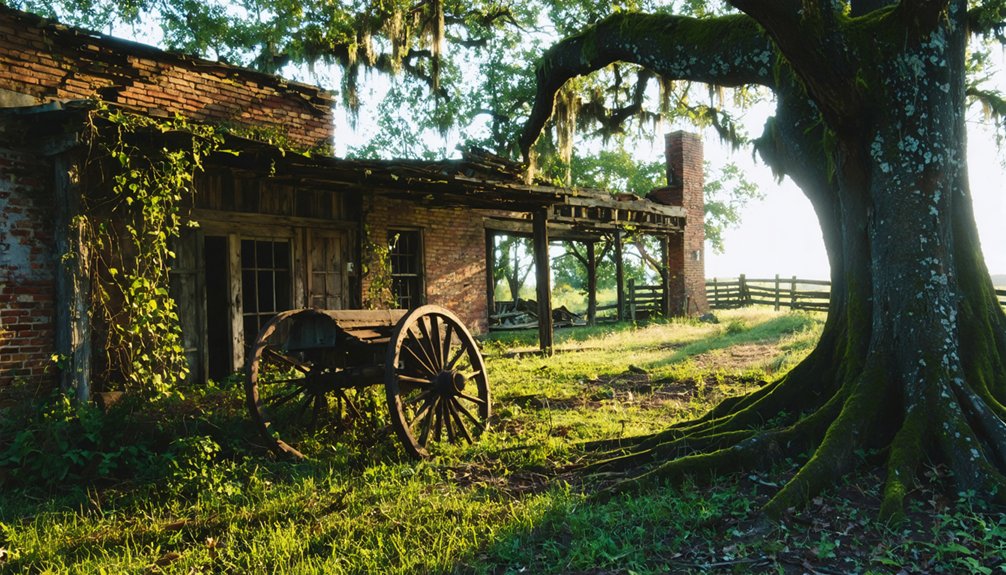You’ll find Lewisburg’s ghostly remains southeast of Morrilton, Arkansas, where this once-bustling river town served as Conway County’s first county seat from 1831-1883. Established in 1825 by the Lewis family, it thrived as an essential trading post and steamboat stop until the Little Rock and Fort Smith Railroad bypassed it. The town’s refusal to support rail construction led to its dramatic decline, with most residents relocating to Morrilton by 1880. The story behind its stone jail ruins reveals a fascinating tale of prosperity, war, and ultimate abandonment.
Key Takeaways
- Lewisburg was a thriving Arkansas River trading post established in 1825, featuring 80 businesses before becoming a ghost town.
- The town’s decline began when railroad tracks were placed in nearby Morrilton, after leaders rejected supporting rail transportation.
- By 1880, most businesses and residents had relocated to Morrilton, abandoning Lewisburg due to limited transportation access.
- Only a stone jail from 1851 remains as one of the few original structures from Lewisburg’s prosperous period.
- Today, Lewisburg exists as a ghost town within a residential neighborhood, marked by historical markers commemorating its past.
Early Trading Post: Birth of a Frontier Settlement
While many frontier settlements emerged along Arkansas’s waterways in the early 1800s, Lewisburg stood out as a particularly promising trading post when Major William Lewis and his son Stephen D. Lewis established it in 1825.
They strategically positioned their trading post along the Arkansas River, about a mile southeast of what would later become Morrilton. You’d have found this economic hub bustling with activity as river traffic brought traders, settlers, and opportunities for commerce. The town’s importance grew as it became a vital stagecoach stop during the challenging period of Indian Removal and the Trail of Tears. The town thrived economically and culturally, boasting two newspapers and numerous businesses during its peak years.
From County Seat to Contested Ground
You’ll find the early courthouse struggles of Lewisburg were marked by humble beginnings, with Dr. Nimrod Menifee and Stephen Lewis establishing the first crude log courthouse in 1831.
The town was a bustling hub for commerce with eighty business establishments operating during its peak years.
During the Civil War, you’d have witnessed both Confederate and Union forces vying for control of this strategic county seat, with the Third Arkansas Cavalry (Union) making Lewisburg their base of operations.
A substantial stone jail facility costing $10,000 was constructed to maintain law and order in the growing community.
Despite the town’s $5,000 investment in a new courthouse in 1873, Lewisburg’s grip on county seat status would ultimately slip away to rival Morrilton by 1883.
Courthouse Power Struggles
Since its establishment as Conway County’s seat in 1829, Lewisburg’s courthouse stood at the center of intense political rivalries and power struggles that would ultimately contribute to the town’s decline.
You’ll find that courthouse control became increasingly volatile after the Civil War, when Union forces burned Springfield’s courthouse, intensifying local disputes.
In 1868, violence erupted as competing factions, including the Williams militia and an African-American militia, clashed in Lewisburg’s streets, leading Governor Clayton to declare martial law.
Democrats later used murder and electoral fraud to solidify their grip on power, while legal battles like United States v. Benjamin G. White exposed the depths of political corruption.
The courthouse remained both a symbol and instrument of authority as rival towns fought for dominance throughout the 1880s and 1890s. After gaining control in 1872, the Democrats quickly moved the county seat to Lewisburg, isolating both Republicans and former slaves. The power struggles finally ended when officials permanently established the seat in Morrilton in 1883.
Civil War Control Battle
The Civil War transformed Lewisburg from a peaceful county seat into a strategic military stronghold. You’d have witnessed a dramatic shift in September 1863, when Union forces under General Frederick Steele’s command seized control of this essential Arkansas River port, raising the Stars and Stripes over the town.
As part of their Union strategy to dominate the Arkansas River Valley, federal forces maintained their grip on Lewisburg until August 1865. The town’s position, just 50 miles west of Little Rock on the route to Fort Smith and Indian Territory, made it an invaluable base of operations. Like Colonel George Crook’s forces in Virginia, the troops maintained a defensive perimeter around the town.
Despite the civil unrest that gripped the region, two companies of Union soldiers were raised locally, suggesting that some residents adapted quickly to the new military presence that would define their town for nearly two years. The area was plagued by violent encounters between Union forces and guerrilla activity, leading to numerous skirmishes throughout the occupation.
Civil War Years and Union Occupation
During the turbulent years of the Civil War, Lewisburg emerged as an essential strategic location along Arkansas’s most important waterway.
You’d have witnessed Union strategies unfold when General Frederick Steele’s troops raised the U.S. flag on September 28, 1863, establishing firm control of this significant river port. Under Colonel Abraham H. Ryan’s command, the Third Arkansas Cavalry maintained order, though they faced persistent guerrilla tactics from Confederate forces led by Colonel Allen R. Witt’s Quitman Rifles.
The garrison faced severe challenges when a devastating smallpox epidemic swept through in 1864, claiming the lives of numerous soldiers.
Conway County sent approximately 900 Confederate soldiers to fight in various units throughout the war, with most never returning home.
You’d have seen the town transform into a bustling military base, with units like the 2nd Arkansas Infantry and the Eleventh U.S. Colored Infantry rotating through until August 1865.
Despite divided local loyalties, Lewisburg’s position made it essential for moving troops and supplies westward to Fort Smith and Indian Territory.
Post-War Reconstruction and Social Changes
Following Union victory in 1865, Lewisburg’s social landscape transformed dramatically with the establishment of a Freedmen’s Bureau office in June 1866.
You’d find Bureau agents working tirelessly to assist with freedmen integration through labor contract negotiations and educational support, while establishing essential schools for the formerly enslaved.
The town’s commitment to education strengthened in 1867 with the opening of the Male and Female Academy, but progress didn’t come without resistance.
You’d witness intense conflicts as the Ku Klux Klan terrorized the community, leading to violent voter suppression and two destructive fires in December 1868.
Governor Clayton’s declaration of martial law brought federal troops to restore order, though economic challenges persisted.
As the agricultural system shifted from slave to free labor, many freedmen struggled to secure stable employment or land ownership.
Railroad’s Impact on Town Development

You’ll find that Lewisburg’s fate hinged dramatically on a single mile – the distance the Little Rock and Fort Smith Railroad chose to place its tracks north of the once-thriving river port.
When town leaders refused the railroad’s request for financial support, believing their river location would sustain them, the company established its station in what would become Morrilton.
This pivotal decision transformed Morrilton into a bustling commercial center while Lewisburg, cut off from the new transportation network, saw its businesses and residents steadily drift away until its complete abandonment by 1880.
Station Location Changes Everything
While Lewisburg thrived as a bustling river town with over 80 businesses in the 1850s, its destiny would ultimately hinge on a single critical decision about railroad placement.
When the Little Rock and Fort Smith Railroad sought financial contributions from Lewisburg’s residents after the Civil War, you’d have witnessed a fateful turning point. The town’s refusal to contribute, based on their assumption that the railroad would need their strategic river location, proved catastrophic.
- E.H. Morrill and James Miles Moose seized the opportunity, donating land for a new depot.
- The railroad’s decision to build one mile north sparked the birth of Morrilton.
- Economic shifts occurred rapidly as businesses and residents relocated to the new rail hub.
Rails Redirect Economic Power
The railroad’s arrival in Arkansas marked a fundamental reshaping of economic power across the state, with Lewisburg’s story serving as a stark example of this transformation.
You can trace the dramatic economic shifts through the stark numbers: Lewisburg’s vibrant community of 80-plus businesses, including mills, hotels, and an opera house, virtually vanished as railroad influence redirected commerce to Morrilton.
When the Little Rock and Fort Smith Railroad chose to build its depot just one mile north of Lewisburg, they weren’t just laying tracks – they were redrawing the region’s economic map.
The impact was swift and absolute. By 1880, Lewisburg’s businesses and residents had abandoned their river-based economy for Morrilton’s rail connections, proving that in the race for prosperity, steam power trumped river trade.
The Great Migration to Morrilton
During the early 1870s, a dramatic population shift transformed the landscape of Conway County as residents and businesses abandoned Lewisburg in favor of the emerging railroad town of Morrilton.
As white residents left Lewisburg behind, African American migration patterns brought newly freed families to the area, often traveling hundreds of miles to seek opportunities around Morrilton’s growing railroad economy.
You’ll find the impact of this change reflected in these significant changes:
- Freedom colonies emerged near Morrilton as safe havens for African American families
- The railroad depot’s relocation in 1875 accelerated Lewisburg’s decline
- Former slaves journeyed from as far as South Carolina, some on foot, to build new lives in Conway County
This migration reshaped the region’s demographics as Morrilton grew into a thriving railroad hub while Lewisburg faded into history.
Architectural Legacy and Lost Landmarks

While you won’t find Lewisburg’s original courthouse standing today, this crucial center of early Conway County justice operated first in a modest log structure before moving to a more substantial wooden building in the 1830s.
You can still spot traces of the old stone jail’s foundation, built in 1851 as one of the few masonry structures in the settlement’s history.
The courthouse and jail complex served as the heart of local government until Morrilton became the new county seat in 1883, marking the end of Lewisburg’s prominence as a civic center.
Historic Courthouse Construction
Located at the confluence of the Arkansas River and Point Remove Creek, Lewisburg’s first courthouse emerged in 1831 as a modest log structure on two acres donated by Dr. Nimrod Menifee.
The courthouse design reflected the early frontier’s civic architecture, built through collaboration between Menifee and Stephen D. Lewis.
When Lewisburg regained county seat status in 1873, you’d have witnessed significant improvements to the town’s judicial infrastructure, including:
- A reconstructed courthouse funded by a $5,000 town donation
- Commissioners W.H. Burrow, W.P. Egan, and D.B. Russell supervising construction
- A substantial stone jail built for $10,000
The new courthouse embodied late 19th-century craftsmanship, utilizing local materials and traditional building methods.
It stood as a symbol of Lewisburg’s civic pride until the county seat’s final relocation to Morrilton in 1883.
Stone Jail Development
As Lewisburg solidified its role as county seat in the late 19th century, a formidable stone jail emerged as the town’s most imposing civic structure, built at a cost of $10,000.
You’ll appreciate how county commissioners prioritized durability and security in its construction, using locally sourced stone that could withstand fire – an essential feature given Lewisburg’s history with flames.
The jail’s stone construction reflected the era’s pragmatic approach to law enforcement infrastructure, serving as both a physical deterrent and a symbol of order during the tumultuous Reconstruction period.
When you visit Lewisburg today, you won’t find this once-mighty landmark – it vanished after the county seat relocated in 1884, marking the beginning of the town’s decline into obscurity.
Tales of Guerrilla Warfare and Local Conflicts
During the tumultuous years of 1863-1865, Lewisburg became a hotbed of guerrilla warfare that pitted neighbor against neighbor in Conway County.
Colonel Allen R. Witt’s Quitman Rifles employed guerrilla tactics against Union forces led by Colonel Abraham H. Ryan, culminating in the Skirmish at Lewisburg on February 12, 1865.
The intensity of local skirmishes left lasting scars on the community, marked by:
- The killing of T. Jeff Williams by Witt’s forces, sparking deadly retaliation from Williams’ family
- Strategic raids on Union supply lines by Confederate Partisan Rangers
- Violent clashes between the Ku Klux Klan and Republican militia during post-war voter registration
You can still sense the echoes of this divided loyalty today, as Lewisburg’s abandoned buildings stand as silent witnesses to a community torn apart by civil strife.
From Bustling Commerce to Abandoned Streets

The rise and fall of Lewisburg tells a story beyond its Civil War conflicts – one of remarkable commercial ambition and eventual abandonment.
You’d have found a thriving river port of 2,000 residents by 1850, where over 80 businesses flourished alongside steamboat traffic and McNabb’s ferry service.
Lewisburg commerce reached impressive heights with its opera houses, newspapers, and diverse mills.
But when the Little Rock and Fort Smith Railroad sought passage in 1875, local leaders made a fatal mistake by refusing to fund it.
You can trace the historic decline as the railroad favored nearby Morrilton, taking with it the courthouse, businesses, and population.
Modern Day Remnants and Historical Significance
While modern-day visitors to Morrilton might struggle to find physical traces of Lewisburg, the ghost town‘s legacy endures within a residential neighborhood that now occupies its original site.
Urban development has erased the physical structures, but you’ll discover the Lewisburg heritage preserved through local markers and the South Howard Street Historic District.
- The 1919 bridge replacement of Lewisburg’s ferry crossing marked the last physical connection to its river commerce era.
- The area’s transformation from county seat to ghost town reflects broader shifts in American transportation and commerce.
- Historical markers now commemorate Lewisburg’s role in Civil War conflicts and its significance as a crucial steamboat port.
Today, the ghost town’s story lives on through these subtle reminders, even as modern homes and streets have replaced the once-bustling river port community that shaped Conway County’s early development.
Frequently Asked Questions
Are There Any Guided Tours Available of the Former Lewisburg Town Site?
You won’t find organized guided tours, but you’re free to explore the historical significance of this site independently. The ghost town’s remains can be discovered through self-guided exploration of the area.
What Happened to the Original Cemetery and Gravesites in Lewisburg?
While you might expect cemetery relocation during Lewisburg’s decline, the original Pioneer Cemetery still exists with about 100 grave markers remaining, though many are weathered and some original burial records were lost.
Did Any Notable People or Celebrities Come From Lewisburg?
You won’t find nationally recognized celebrities from Lewisburg, but notable residents included Major William Lewis, Dr. Nimrod Menifee, and military figures who shaped the town’s historical significance during settlement and Civil War.
Are There Any Preserved Artifacts From Lewisburg in Local Museums?
Truth be told, you won’t find preserved artifacts from Lewisburg in local museums. While nearby Hampson Museum houses Native American collections from the region, nothing’s been specifically documented from Lewisburg’s trading post days.
Can Visitors Still See Foundations or Ruins of Original Lewisburg Buildings?
You won’t find visible architectural remnants at the former townsite today. Despite its historical significance, nature has reclaimed the area, leaving no recognizable foundations or building ruins for visitors to explore.
References
- https://encyclopediaofarkansas.net/entries/skirmish-at-lewisburg-6842/
- https://www.hmdb.org/m.asp?m=170456
- https://www.arkansasheritage.com/arkansas-register/south-howard-street-historic-district
- http://genealogytrails.com/ark/conway/cohist.html
- https://en.wikipedia.org/wiki/Lewisburg
- https://en.wikipedia.org/wiki/List_of_ghost_towns_in_Arkansas
- https://encyclopediaofarkansas.net/entries/lewisburg-conway-county-2725/
- https://encyclopediaofarkansas.net/entries/morrilton-857/
- https://www.arkansasheritage.com/docs/default-source/ahpp-documents/sandwiching-tour-scripts/moose_addition_hd_morrilton_tour_script_20144a41e11b-422c-454a-bff3-63b2205ba5a3.pdf?sfvrsn=460dc1b7_5
- https://www.livelovearkansas.homes/blog/2024/07/15-morrilton-small-town-charm



